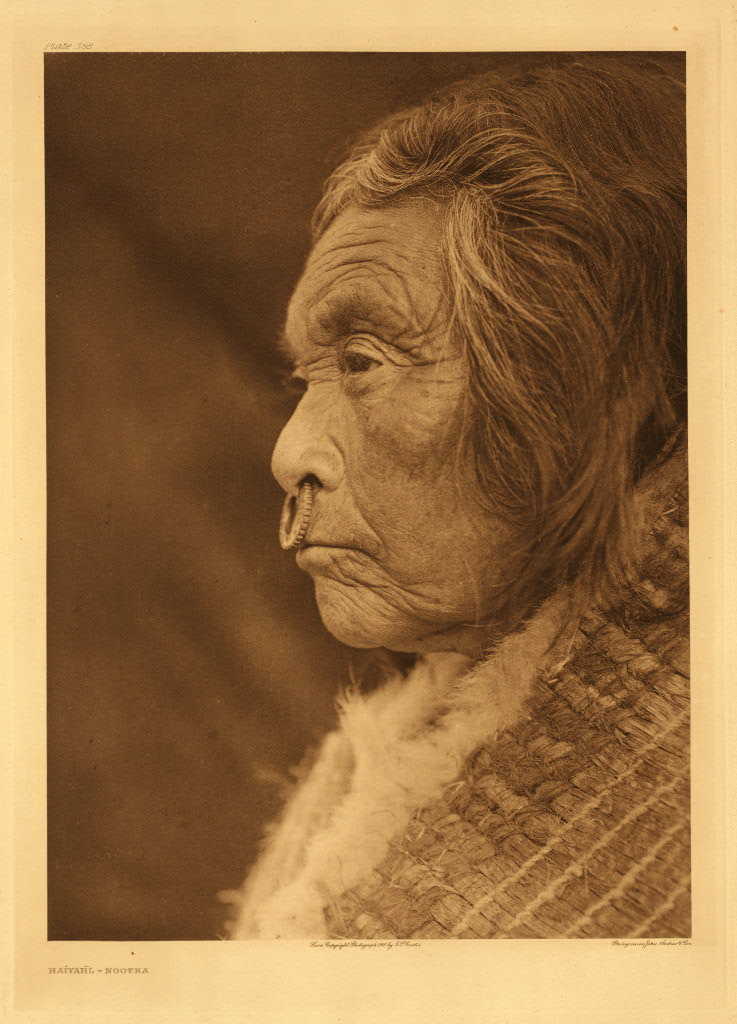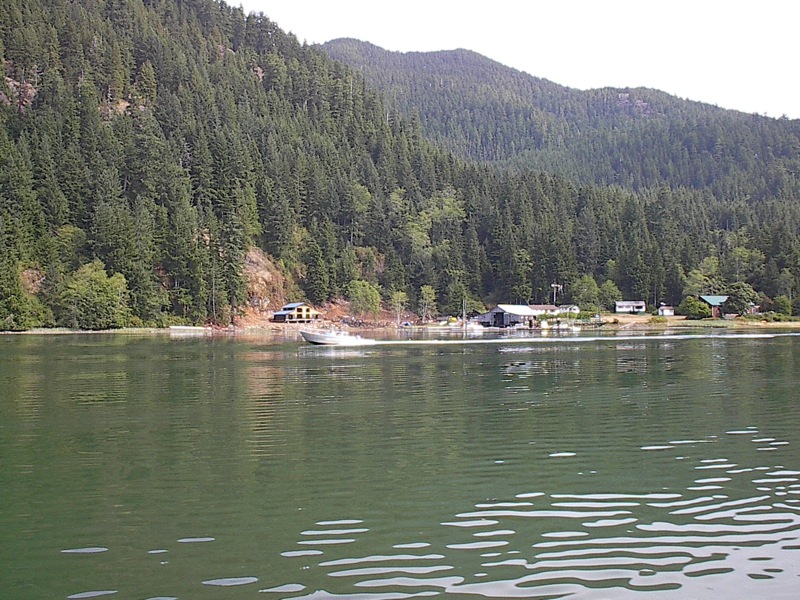Browse "Indigenous Peoples"
-
Article
Nuu-chah-nulth (Nootka)
Nuu-chah-nulth (Nootka) are Indigenous peoples of the Pacific Northwest Coast in Canada. When Captain James Cook encountered Nuu-chah-nulth villagers at Yuquot (Nootka Island, west of Vancouver Island) in 1778, he misunderstood the name for their nation to be Nootka, the term historically used to describe the Nuu-chah-nulth. The inlet where Cook first encountered the Nuu-chah-nulth is now known as Nootka Sound. In 1978, the Nuu-chah-nulth chose the collective term Nuu-chah-nulth (nuučaan̓uł, meaning “all along the mountains and sea”) to describe the First Nations of western Vancouver Island. In the 2016 census, 4,310 people identified as having Nuu-chah-nulth ancestry, 380 people reported the Nuu-chah-nulth language as their mother tongue.
"https://d2ttikhf7xbzbs.cloudfront.net/media/media/5c1e83c0-b312-4b79-a6ec-6f45c2a40e2b.jpg" // resources/views/front/categories/view.blade.php
https://d2ttikhf7xbzbs.cloudfront.net/media/media/5c1e83c0-b312-4b79-a6ec-6f45c2a40e2b.jpg
-
Article
Northern Youth Abroad
Northern Youth Abroad is a registered not-for-profit charity. Since 1998, it has provided education and travel opportunities for over 550 young people, aged 15 to 22, from every community in Nunavut and the Northwest Territories. The programs are designed to foster cross-cultural awareness and global citizenship, while building the self-confidence and self-esteem necessary to help develop life and career goals.
"https://d2ttikhf7xbzbs.cloudfront.net/NorthernYouthAbroad/14496009746_0e4e140273.jpg" // resources/views/front/categories/view.blade.php
https://d2ttikhf7xbzbs.cloudfront.net/NorthernYouthAbroad/14496009746_0e4e140273.jpg
-
List
Notable Indigenous Entrepreneurs in Canada
Indigenous economies thrived long before Europeans arrived in North America and, due to hard work and ingenuity, a growing number of Indigenous entrepreneurs are enjoying success today. Many are demonstrating a blending of traditional values and an Indigenous world view with financial success. The following are but a few of a long list of remarkable Indigenous entrepreneurs running thriving businesses in Canada. (See also Economic Conditions of Indigenous Peoples in Canada.)
"https://d2ttikhf7xbzbs.cloudfront.net/IndigenousEntrepeneurs/JeffWard.jpg" // resources/views/front/categories/view.blade.php
https://d2ttikhf7xbzbs.cloudfront.net/IndigenousEntrepeneurs/JeffWard.jpg
-
List
Notable Women Entrepreneurs in Canadian History
Women have had a long history of entrepreneurship in Canada and their involvement continues to grow. The entrepreneurs listed below are just a few examples of the many women who have made their mark on Canadian business history.
"https://d2ttikhf7xbzbs.cloudfront.net/beverlymascoll/beverlymascoll.jpg" // resources/views/front/categories/view.blade.php
https://d2ttikhf7xbzbs.cloudfront.net/beverlymascoll/beverlymascoll.jpg
-
Article
Nuchatlaht
The Nuchatlaht (“people of the mountain”) are a Nuu-chah-nulth First Nation residing on the northwest coast of Vancouver Island, British Columbia. According to the federal government, the Nuchatlaht numbered 167 registered members, as of October 2021.
"https://d2ttikhf7xbzbs.cloudfront.net/media/media/5a1a5452-f764-4af1-9b30-bbb8db8257dc.jpg" // resources/views/front/categories/view.blade.php
https://d2ttikhf7xbzbs.cloudfront.net/media/media/5a1a5452-f764-4af1-9b30-bbb8db8257dc.jpg
-
Article
Numbered Treaties (Plain-Language Summary)
The Numbered Treaties are a series of 11 treaties. A treaty is an agreement between two or more nations. The Numbered Treaties were signed by the Canadian government and Indigenous people. All 11 treaties were signed between 1871 and 1921. The Numbered Treaties cover parts of British Columbia, Alberta, Saskatchewan, Manitoba, Ontario. They also cover portions of Yukon and the Northwest Territories. The treaties provided the Canadian government with land. The government wanted land for industrial development and white settlement. In exchange, the government promised Indigenous people special rights and benefits. These treaty terms are controversial and contested. The Numbered Treaties have ongoing legal, social, and economic impacts on Indigenous communities. (See also Treaties with Indigenous Peoples in Canada.) (This is a plain-language summary of the Numbered Treaties. If you are interested in reading about this topic in more depth, please see our full-length entry, Numbered Treaties.)
"https://d2ttikhf7xbzbs.cloudfront.net/media/media/4f1d71aa-8b25-417f-a88b-2a078f3b1768.jpg" // resources/views/front/categories/view.blade.php
https://d2ttikhf7xbzbs.cloudfront.net/media/media/4f1d71aa-8b25-417f-a88b-2a078f3b1768.jpg
-
Article
Nuxalk (Bella Coola)
The Nuxalk are an Indigenous people in Canada. Their traditional territories are in and around Bella Coola, British Columbia. The term "Bella Coola" once referred collectively to the Nuxalk, Talio, Kimsquit and some Kwatna who inhabited villages around North Bentinck Arm and the Bella Coola Valley, South Bentinck Arm, Dean Channel and Kwatna Inlet. Since the late 1970s, the Nuxalk have called themselves the Nuxalk Nation, derived from the term that in earlier times referred exclusively to the people of the Bella Coola Valley. In 2020, the Government of Canada reported the registered population of Nuxalk was 1,786, with 912 people living on reserves. (See also First Nations and Northwest Coast Indigenous Peoples in Canada.)
"https://d2ttikhf7xbzbs.cloudfront.net/media/media/f1d6e60c-9c3c-4aaf-a418-f354cdc47d83.jpg" // resources/views/front/categories/view.blade.php
https://d2ttikhf7xbzbs.cloudfront.net/media/media/f1d6e60c-9c3c-4aaf-a418-f354cdc47d83.jpg
-
Article
Odawa
Odawa (or Ottawa) are an Algonquian-speaking people (see Indigenous Languages in Canada) living north of the Huron-Wendat at the time of French penetration to the Upper Great Lakes. A tradition of the Odawa, shared by the Ojibwa and Potawatomi, states that these three groups were once one people. The division of the Upper Great Lake Algonquians apparently took place at Michilimackinac, the meeting point of lakes Huron and Michigan. The Odawa, or "traders," remained near Michilimackinac, while the Potawatomi, "Those-who-make-or-keep-a-fire," moved south, up Lake Michigan. The Ojibwa (Ojibwe), or "To-roast-till-puckered-up," went northwest to Sault Ste Marie.
"https://d2ttikhf7xbzbs.cloudfront.net/media/media/7f43d674-3179-4006-afce-5521ddca5b0a.jpg" // resources/views/front/categories/view.blade.php
https://d2ttikhf7xbzbs.cloudfront.net/media/media/7f43d674-3179-4006-afce-5521ddca5b0a.jpg
-
Article
Odawa
Odawa (or Ottawa) are an Algonquian-speaking people living north of the Huron-Wendat at the time of French penetration to the Upper Great Lakes. A tradition of the Odawa, shared by the Ojibwa and Potawatomi, states that these three groups were once one people.
"https://development.thecanadianencyclopedia.ca/images/tce_placeholder.jpg?v=e9dca980c9bdb3aa11e832e7ea94f5d9" // resources/views/front/categories/view.blade.php
https://development.thecanadianencyclopedia.ca/images/tce_placeholder.jpg?v=e9dca980c9bdb3aa11e832e7ea94f5d9
-
Article
Ojibwe
The Ojibwe (also Ojibwa and Ojibway) are an Indigenous people in Canada and the United States who are part of a larger cultural group known as the Anishinaabeg. Chippewa and Saulteaux people are also part of the Ojibwe and Anishinaabe ethnic groups. The Ojibwe are closely related to the Odawa and Algonquin peoples, and share many traditions with neighbouring Cree people, especially in the north and west of Ontario, and east of Manitoba. Some Cree and Ojibwe peoples have merged to form Oji-Cree communities. In their traditional homelands in the Eastern Woodlands, Ojibwe people became integral parts of the early fur trade economy. Ojibwe culture, language (Anishinaabemowin) and activism have persisted despite assimilative efforts by federal and provincial governments, and in many cases are representative of the enduring First Nations presence in Canada.
"https://d2ttikhf7xbzbs.cloudfront.net/media/Twitter_Cards/Autumn Peltier.png" // resources/views/front/categories/view.blade.php
https://d2ttikhf7xbzbs.cloudfront.net/media/Twitter_Cards/Autumn Peltier.png
-
Article
Kanesatake Resistance (Oka Crisis)
The Kanesatake Resistance, also known as the Oka Crisis or the Mohawk Resistance at Kanesatake, was a 78-day standoff (11 July–26 September 1990) between Kanyen'kehà:ka (Mohawk) protesters, Quebec police, the RCMP and the Canadian Army. It took place in the community of Kanesatake, near the Town of Oka, on the north shore of Montreal. Related protests and violence occurred in the Kahnawake reserve, to the south of Montreal. The crisis was sparked by the proposed expansion of a golf course and the development of townhouses on disputed land in Kanesatake that included a Kanyen'kehà:ka burial ground. Tensions were high, particularly after the death of Corporal Marcel Lemay, a Sûreté du Québec police officer. Eventually, the army was called in and the protest ended. The golf course expansion was cancelled, and the land was purchased by the federal government. However, it did not establish the land as a reserve, and there has since been no organized transfer of the land to the Mohawks of Kanesatake. This is the full-length entry about Kanesatake Resistance (Oka Crisis). For a plain-language summary, please see Kanesatake Resistance (Oka Crisis)(Plain-Language Summary).
"https://d2ttikhf7xbzbs.cloudfront.net/media/new_article_images/OkaCrisis/1990_C_35_7 (003).jpg" // resources/views/front/categories/view.blade.php
https://d2ttikhf7xbzbs.cloudfront.net/media/new_article_images/OkaCrisis/1990_C_35_7 (003).jpg.jpg)
-
Article
Olive Dickason
Olive Patricia Dickason (née Williamson), CM, Métis journalist, historian, university professor, author (born 6 March 1920 in Winnipeg, MB; died 12 March 2011 in Ottawa, ON). Dickason was the first scholar in Canada to receive a PhD in Indigenous history. Her ground-breaking research and books about Indigenous and Métis history and culture transformed how Canadians perceive the origin of their country and Indigenous peoples. Dickason’s work inspired a new generation of scholars, helping to launch Indigenous studies as an area of scholarly research. She received an Order of Canada in recognition of her achievements.
"https://d2ttikhf7xbzbs.cloudfront.net/media/new_article_images/OliveDickason/Canada's First Nations.jpg" // resources/views/front/categories/view.blade.php
https://d2ttikhf7xbzbs.cloudfront.net/media/new_article_images/OliveDickason/Canada's First Nations.jpg
-
Article
Olivia Poole
Susan Olivia Davis Poole, inventor (born 18 April 1889 in Devils Lake, North Dakota; died 10 October 1975 in Ganges, BC). Olivia Poole was raised on the Ojibwe White Earth Reservation in Minnesota. There, she was inspired by the traditional practice of using a bouncing cradleboard to soothe babies. In 1957, she patented her invention of the baby jumper, under the name Jolly Jumper, making her one of the first Indigenous women in Canada to patent and profit from an invention.
"https://d2ttikhf7xbzbs.cloudfront.net/Poole 1.jfif" // resources/views/front/categories/view.blade.php
https://d2ttikhf7xbzbs.cloudfront.net/Poole 1.jfif -
Article
Oneida
The Oneida (Onyota’a:ka “People of the Standing Stone”) are an Indigenous nation in Canada. The Oneida are one the five original nations of the Haudenosaunee Confederacy. Historically, the Oneida occupied a village near Oneida Lake in New York state. They also occupy territory in southwestern Ontario. Oneida people live both on and off reserves. As of November 2023, the Government of Canada reported 6,503 members of Oneida Nation of the Thames and 2,254 Oneida members of Six Nations of the Grand River. (See also First Nations and Indigenous Peoples in Canada.)
"https://d2ttikhf7xbzbs.cloudfront.net/Flag_of_the_Oneida_of_the_Thames_First_Nation.png" // resources/views/front/categories/view.blade.php
https://d2ttikhf7xbzbs.cloudfront.net/Flag_of_the_Oneida_of_the_Thames_First_Nation.png
-
Article
Onondaga
The Onondaga are an Indigenous nation in Canada. They make up one-sixth of the Haudenosaunee Confederacy; the rest include the Kanyen’kehà:ka (Mohawk), Cayuga, Seneca, Oneida and Tuscarora. Onondaga traditional territory is located outside Syracuse, New York. Onondaga peoples also live on Six Nations territory near Brantford, Ontario. According to the Government of Canada, in January 2024, there were 711 registered members of the Bearfoot Onondaga First Nation and 892 registered members of the Onondaga Clear Sky First Nation. (See also First Nations.)
"https://d2ttikhf7xbzbs.cloudfront.net/3546949418_5e04fd2103_b.jpg" // resources/views/front/categories/view.blade.php
https://d2ttikhf7xbzbs.cloudfront.net/3546949418_5e04fd2103_b.jpg

